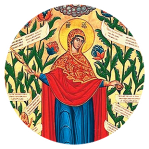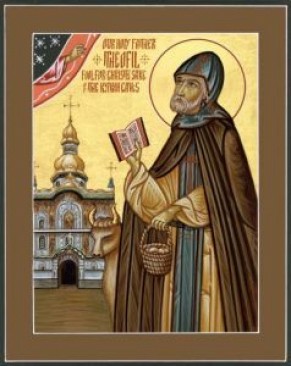“Feofil breaks the rule and order. . . . No one knows where he might read his prayers. . .. He barely participates in the . . . liturgy . . . He stands before the altar-table as if dumbfounded and requires constant direction . . ..he bends down and wipes his nose with the garments of the altar table .” These were just some of the official complaints about the Hieroschemamonk Feofil.
He was born in Russia in 1788, one of a pair of twins. His life started out rather badly. His mother, convinced he was a changeling of the devil, tried to kill him, not just once, but three times! Each time, someone was able to stop her, even when she threw him into a mill pond and he was sucked beneath the turning mill wheel. It seems God had His eye on this mite of a person even then!
Friendly neighbors realized that his mother was probably not the best guardian for him, but he wasn’t able to be settled anywhere – he passed from person to person until his uncle, a priest, enrolled him at the Bratsky Monastery ecclesiastical academy. He settled down there and finished his education. Then, in 1812, when he was 24, he entered the Kiev Bratsky Monastery, where he delighted in attending services.
He was tonsured Feodorit in 1821 and ordained a heiromonk (priest-monk) in 1827. By all reports, he
was obedient and zealous in his devotion to God. So much so, that in that same year, Feodorit was appointed steward of the monastery. It was a singular honor, but it was one he didn’t want. Understandably, his early experiences had left him with a love of solitude and an awkwardness and discomfort around people. He was much happier alone, praying and reading his Psalter. He begged the igumen for release from the stewardship but was refused.
That was when “Feordorit took the path of special asceticism and took upon himself the great podvig of ‘fool-for-Christ’s-sake’.” In spite of his behavior, his superiors noticed his humility and spiritual purity, and in 1834, he took the schema* and was given the name Feofil.
His behavior after that scandalized the monastery and the surrounding villages. He placed an old coffin in his cell and filled it with provisions and dishes. He sewed pieces of old rags around his cowl and wore them until his death. He was called “the dirty, ragged monk” and the metropolitan heard many complaints about him.
Undaunted, Feofil increased his devotion to God and his podvig (burden or chore) of foolishness, and for his devotion, God blessed him with the ability to discern the hearts of his spiritual children. The laity around the monastery crowded around the gates, hoping for a blessing from him, or for a word, or for a foretelling of their future, or wondered how to gain such gifts for themselves.
One man asked him how it was that he could know the future. The Blessed Feofil told him there was nothing difficult about it and asked the man if he wanted to be able to do the same.
“Very much so, Father, teach me.”
“Pull a small hair from your eyelash and tie two knots in it. When you can do that, you will be as wise as I am.”
When the man confessed he couldn’t manage the trick, the monk told him, “That is how difficult it was for me to attain my present condition.”
In 1844, at fifty-five years of age, Blessed Feofil was transferred to Goloseyevskaya Hermitage near Kiev, and it wasn’t long before the people of the area learned of his piety and holiness.
The reports of him from this time reveal how he changed in a just a few years. In 1845, Igumen Grigory wrote that Father Feofil is “capable and careful in obedience, honest, meek and humble in behavior”. Yet, by 1848, he is described as “not capable for anything at all; he is without any obedience, is stubborn and arbitrary. . .” to the extent that the Metropolitan forbade him to take part in services and he was only allowed communion on Saturdays.
Eventually, Father Feofil was transferred to the Kitayevskaya Hermitage near Kiev. This suited him, for the place was surrounded by high hills and thick woods, and he would plunge deep into the heart of them, to pray and study his Psalter.
His appearance deteriorated as his devotion to God increased, and as he used his foolishness for the edification of others. His clothes were threadbare and patched, stained and dirty with oil and dough. He wore torn slippers or a worn-out high boot on one foot and a felt boot on the other.
Yet his prayers and devotions were constant; each day, he made countless prostrations before his icons. He lay on a log placed against his stove bed, or sat on a narrow bench, so that if he fell asleep, he would fall, wake up, and return to his prayers.
His cell was a mess – dirty and unkempt, jammed with layers of rubbish, pots and crocks containing food for visitors – groats, tea, flour, sugar, bread, honey, and roe. When people asked him about it, he told them that he left it that way in order to remind himself of the disorder of his soul.
In 1853, he was moved to Goloseyevo Monastery. During the last months of his life, he acquired an even greater inner peace and serenity, and was more welcoming of those who wished his advice and blessing. But he always besought his visitors not to forget to pray for the “smelly” Feofil. His discernment of people’s hearts and healing miracles continued, even though he was ill.
In the fall of 1853, he called his cell mate to the window of their cell, and asked Panteleimon to look “at the cross above the grave. Do you see it?” Panteleimon saw nothing. To his eyes, the view was as it always was. He left a few days later on a pilgrimage, and did not return until St. Feofil had reposed, but when he did the grave and the cross were in exactly the place the saint had pointed out.
On the morning of October 28, the Holy Fool received the Holy Mysteries in the morning, in his cell, and part way through the day, sent another of his cell mates to the superior of the monastery, with a request to toll the bell for his repose. The igumen hurried to Father Feofil’s cell, but the Blessed One had gone before he got there, leaving behind an emaciated, broken body and a marvelous, indefinable fragrance.
*The schema is both a degree of monasticism and an article of clothing. A schema monastic is one who has attained a high degree of spiritual advancement, and once granted this honor, he or she wears the schema, or analavos, a garment covering his (or her) robes which drapes over the shoulders and hangs down in front and back. It’s embroidered with the instruments of the passion and the Trisagion. Some forms have a hood.
Bev. Cooke has been writing for publication since 1989. Her first love is writing for young adults, and she has three YA books on the market: Keeper of the Light, a historical fiction about St. Macrina the Elder in 2006. Royal Monastic, a biography of Mother Alexander (Princess Ileana of Romania), also published by Conciliar came out in 2008. Feral, an edgy mainstream novel was released by Orca Book Publishers in 2008.
Source: http://myocn.net/st-feofil/
Used by permission of Orthodox Christian Network (OCN).


